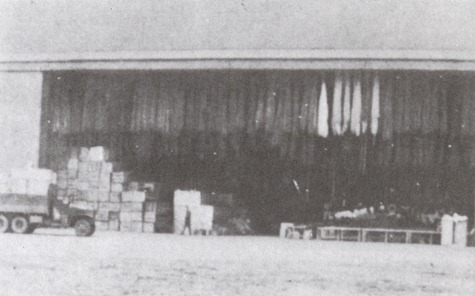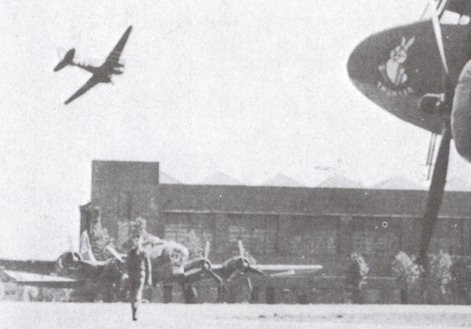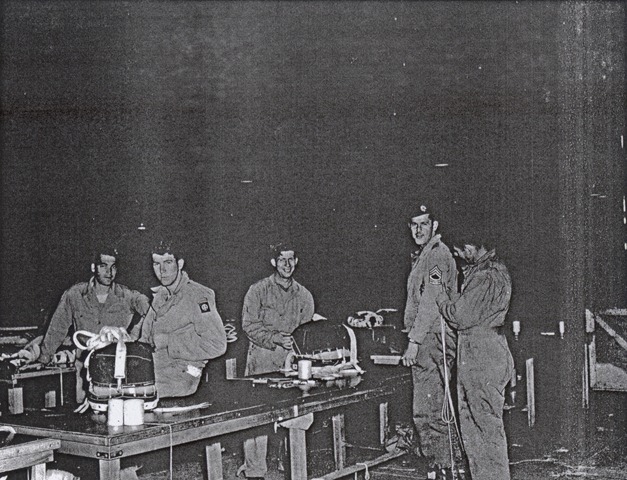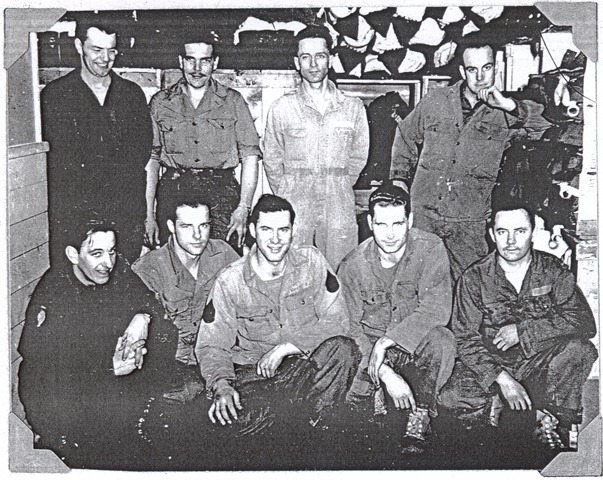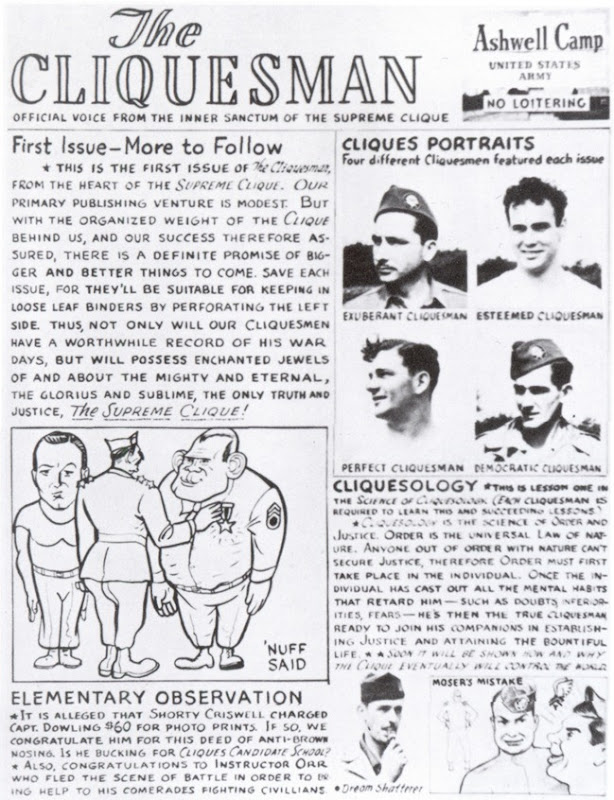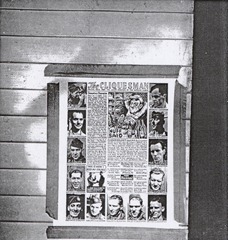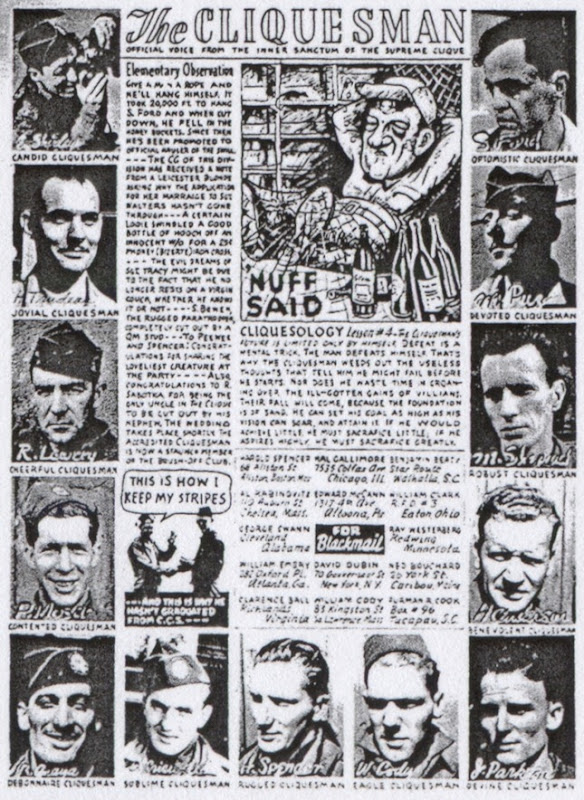Movement from Northern Ireland to England
During the period before and after the Normandy campaign the 505 paratroopers made a memorable mark on Leicestershire County. The riggers of the 82nd Parachute Maintenance Company did likewise at their station in neighboring Rutland County.
On February 13 - 14, 1944 the units of the 505 moved out from their bases in Northern Ireland and embarked on a journey taking them by ship from the docks at Belfast harbor to the port of Glasgow, Scotland. There they boarded trains which wound their way through the dramatic scenery of the Scottish countryside, notably taking in the site of Hadrian’s Wall in the vicinity of Carlisle. The wall was built by the Roman’s around 122 – 128 AD to keep the northern marauding tribes from Roman occupied Britain. They made their way on south to the English Midlands arriving at Leicester. At that point they were placed on trucks to each unit’s final destination at various places around the area. The 505th PIR made camp at Quorn near Leicester. The 505 riggers along with those of the 508, 507, and sundry smaller rigger outfits were stationed at nearby Ashwell camp near Cottesmore airfield, in Rutland county, in the vicinity of the village of Langham and the larger town of Oakham. Source: “Ready: A World War II History of the 505th Parachute Infantry Regiment” Langdon A., 1986, p. 35; Source: “82nd Airborne Division: 82nd Parachute Maintenance Company”. Author unknown. Date unknown., p. 9; Source: “Me or You” Schlesener M., 2005, pp. 45- 46
View Belfast - Glasgow - Leicester in a larger map
Map 1: The 505th PIR approximate route from Belfast to Leicester.
Note:- Click on the lines and blue place markers for more information
View 505th PIR and 82nd PMC Camps in a larger map
Map 2: 505th PIR camped at Quorn. The 82nd PMC were stationed at Ashwell camp.
Note:- Click on the blue place markers for more information
The troopers stationed at Quorn were quartered in tents in the town. The riggers at Ashwell camp were housed in some of the best quarters of the entire war. According to the unpublished history of the 82nd Airborne Parachute Maintenance Company:
“Not much time was needed to improve the camp though, as it had been built for the WAAF’s [the UK’s Women’s Auxiliary Air Force]. This was undoubtedly the most ideal camp the men had ever lived in. The living quarters were in three main groups with fairly small wings consisting of small rooms. Source: “82nd Airborne Division: 82nd Parachute Maintenance Company”. Author unknown. Date unknown., p. 9
Another account by Julian Jenkins. a researcher for the Langham village history exhibition of 2000 fills in some of the details for why the quarters were so good – reasons anyone whose gone without the luxury of bathing for an extended period of time will appreciate:
“To many of the paratroopers, Ashwell camp was the finest camp they saw overseas…The camp had steam heated showers, electricity and running water, which had not been previously available.” Source: “Langham’s Wartime Experiences American Style”, Jenkins, J., pp. 2-3 circa 2000.
Today a prison now stands in the area that was once Ashwell camp. At only four miles to the north east as the crow flies, Ashwell camp was in close proximity to Cottesmore airfield. The unpublished history of the 82nd Airborne Parachute Maintenance Company states:
“Here, they had plenty of room for packing and maintenance as they had Hanger “A” on Cottesmore Airport, a few buildings in the Company area for storage and the 505th [riggers] maintenance section. They started packing right away. The maintenance section added more men to their little group to operate all the sewing machines.” Source: “82nd Airborne Division: 82nd Parachute Maintenance Company”. Author unknown. Date unknown., p. 9
Below are some pictures of Hanger A where the 82nd riggers toiled long hours maintaining and packing and repacking the thousands of chutes for the many practice jumps made by the 505, 507, and 508 parachute infantry regiments in the lead up to the Normandy jump and later for the 504, 505, and 508 PIRs prior to the Nijmegen drop during operation Market Garden.
Ashwell camp was the site of the 82nd Airborne’s Division’s overseas “jump school”. Not only did the riggers at Ashwell have to pack and maintain chutes for training in the upcoming combat jumps. They also had to work to pack additional chutes for use by the jump school to train raw would be paratroopers sent directly from the US to undergo paratrooper certification training in England instead of at Fort Benning, Georgia. “An approximate total of 17,500 chutes were used by the school”. Source: “82nd Airborne Division: 82nd Parachute Maintenance Company”. Author unknown. Date unknown., p. 11
On August 19, 1944 the 507th riggers left Ashwell camp as part of that regiment’s detachment from the 82nd Airborne Division in order to join the 17th Airborne Division. The departure of the 507 riggers reduced the pool of riggers which caused rescheduling of the installation’s throughput.
Parachutes drying in Hanger A at Cottesmore Airfield. The patch of light in the middle of the picture gives an idea of the operation’s scale. Source: “Saga of the All American” Dawson, Forrest W., 1946, unpaginated
Parachutes drying in Hanger A at Cottesmore Airfield. Source: “Saga of the All American” Dawson, Forrest W., 1946, unpaginated
Hanger A Cottesmore Airfield where the 82nd riggers worked Source: “Saga of the All American” Dawson, Forrest W., 1946, unpaginated
82nd Riggers at packing tables posing with packed chutes. Source: “82nd Airborne Division: 82nd Parachute Maintenance Company”. Author unknown. Date unknown., Photographic section.
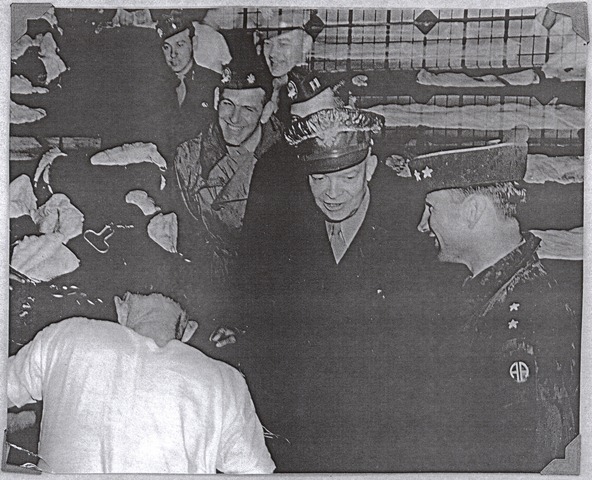 General Eisenhower inspecting the 82nd rigger’s operation accompanied by Lt. General Gavin on a rainy day. Demonstrates just how vital the rigger’s work was to success in airborne operations. Source: “82nd Airborne Division: 82nd Parachute Maintenance Company”. Author unknown. Date unknown., Photographic section.
General Eisenhower inspecting the 82nd rigger’s operation accompanied by Lt. General Gavin on a rainy day. Demonstrates just how vital the rigger’s work was to success in airborne operations. Source: “82nd Airborne Division: 82nd Parachute Maintenance Company”. Author unknown. Date unknown., Photographic section.
82nd Riggers with packed parachutes and associated equipment on shelves in background. Location unknown . Source: “82nd Airborne Division: 82nd Parachute Maintenance Company”. Author unknown. Date unknown., Photographic section.
It started when an unfortunate jumper plunged to his death on the jump field at Langham. Indeed - many people, including men from the camp, witnessed the chute’s failure to open and went over to view the body. Evidently it left a strong impression, for only a few days passed before his ghost was sighted by moonlight along the lonely hedgerows. He stood, so the many that saw him said, wavering, white, wearing his blood-spattered harness and holding his gore-filled helmet at his side. This was enough to make the superstitious carry Colt forty-five revolvers on their hips and go to Langham by another route...” Source: “Langham’s Wartime Experiences American Style”, Jenkins, J., p. 3 circa 2000.
Below are some Google Street Views of the countryside along the Burley road between Ashwell camp and the village of Langham. Note:- You can use your mouse to pan around to change perspective.
View Jump training countryside along Burley rd, Langham in a larger map
View More jump training countryside, Burley Rd Langham in a larger map
View Burley Rd Langham in a larger map
Local People and Relationships
The 505 troopers quickly formed friendships with the hospitable locals whom readily welcomed them. Just as in Northern Ireland many lifelong relationships were formed. Passes were liberal except for when night exercises were planned. On most nights a trooper was able to get a pass. Often they were taken at local pubs where they would socialize and drink English beer. Source: “Put on Your Boots and Parachutes: The United States 82nd Airborne Division” Wills , D., 1992, p. 39
As soon as they could the riggers at Ashwell camp travelled to Oakham to buy bicycles which they used to travel to and from local pubs in the area. In nearby Langham they frequented the Noel Arms, the Black Horse, and Wheatsheaf pubs. They also went to dances in Oakham. Source: “Langham’s Wartime Experiences American Style”, Jenkins, J., p. 2 circa 2000.
“It was here [in the pubs of Langham] amid the laughter, smoke laden atmosphere and tinkling of beer glasses, that so many pleasant darts matches were enjoyed by soldier and civilian alike.” Source: “Langham’s Wartime Experiences American Style”, Jenkins, J., p. 2 circa 2000.
Here’s a map of the route from Ashwell camp to the local pubs in Langham where many 82nd PMC men spent their time while off duty.
View 82nd PMC Off Duty Pubs in a larger map
Road from Ashwell camp to the village of Langham.
Note:- Click on the lines and blue place markers for more information
Bill had fond memories drinking and socializing with his buddies and the locals in the English pubs. It was a welcome relief from his work and training and at times he said it made it easy to temporarily forget there was a war on. Like so many US servicemen stationed in England in WWII, Bill recalled his dislike of the English beer because he said it lacked flavor and was served “warm” – possibly meaning cellar temperature of perhaps 50 – 60 degrees Fahrenheit (around 10 – 15 degrees Celsius) – instead of the cold as he was accustomed to in the States. He would sprinkle salt in it for seasoning, but said it did little to help. I have heard in several accounts that due to war rationing at the time, the ingredients for making beer were, like everything else, in short supply. The local pubs and commercial brewing companies had to make do with the meager stores of hops, sugar, yeast, etc., making the beer of lesser quality than in pre-war years. Certainly, in my experience at least, in post-war years, English beers served on tap in local pubs are very good.
There are some reports that the troopers would ask for the beer to be served with ice when it was available. When the locals in Quorn saw this they tried it for themselves and began asking for the same. Source: “Put on Your Boots and Parachutes: The United States 82nd Airborne Division” Wills , D., 1992, p. 40
Interaction with British Paratroopers
After the war Bill would often express his admiration for British paratroopers. He would describe how during down time in training sessions the British would pound the edge of their hands against buildings to increase the callous to be used for breaking necks. Bill had a profound reverence for those paratroopers and would eagerly recount how good they were. As mentioned in the post Gavin’s Boys Bill told a story of how he got into a fight at a pub with a big British paratrooper whom he said with a smile “beat the absolute tar out of me”. Bill’s first interactions with the British airborne most likely occurred while stationed at Ashwell camp.
According to Julian Jenkins:
“[The] British 1st Airborne section had also helped the 82nd to settle in at Cottesmore.” Source: “Langham’s Wartime Experiences American Style”, Jenkins, J., p. 4 circa 2000
It’s probable that during that time both airborne units trained together or at least in close proximity to one another. That would be the only explanation for Bill’s memory of them pounding their hands against buildings to increase the callous on their hands, during downtime in training sessions. In the post Normandy Part 2: A Combat Rigger’s Mission Bill said he trained in Sherwood forest in commando style fighting techniques. Indeed the 505th PIR trained at the British Commando school which was located in the very same forest. Both the 1st and 6th British Airborne Divisions trained there before Normandy at the time 82nd Airborne was stationed in England. Given his recollections, Bill most likely met with British Paratroopers while training there, trained with them and/or was taught by British airborne commando trainers.
Buzz Bomb Attack
When the 82nd Airborne returned from Normandy the men received 5 or 6 day furloughs. As mentioned in the first post on Normandy Bill used his to visit his brother Henry in late July, 1944 at his base at Heston aerodrome just outside of London. The two brothers talked a lot during that time, but they also went out on pub crawls. Henry wrote that one night they visited the North Star Pub, where Bill flush with his unspent paratrooper wages funded the drinks for Henry and his 47th Squadron buddies. He later reported in a letter home that:
“I had a six day furlough. Had a very good time, but I spent a lot of money. A person can have a good time in London, but it costs a lot for food etc.” Source: “Letter written home” Clark, W., January 14 1945, p. 1
It was during one of these pub crawls that they were walking on their way to a watering hole when they came under an air attack from V-1 flying bombs. Following protocol, Henry and his friends dove behind walls and into ditches, or whatever cover they could find. Henry had already seen a “Doodlebug” fly over his base and read about a subsequent attack that killed 80 women working in a nearby factory. So he understood too well the very real danger they were all in. Once he found cover he looked for his brother, but to his shock and dismay he saw that Bill had merely continued walking up the road, completely ignoring the buzzing of the incoming ordinance. Henry shouted to Bill to take cover, but he turned around and laughed at the other men for diving so dramatically for the deck. There were some explosions in the distance, but they were too far away for any of the shrapnel or debris to come down on them. Henry and his buddies, already in awe of Bill for his obvious courage as a paratrooper, were now all the more impressed and a little intimidated by his lack of fear. Some days after Bill returned to Ashwell camp, the main gate at Henry’s base took a direct by a Buzz Bomb which killed several people and damaged buildings at the base. For an hour after the blast, everyone at the base had diminished hearing.
A Chance Encounter in London
In the months leading up to the invasion men were also issued passes at various times, enabling them to travel to larger towns and cities. Before his brother Henry arrived in England on April 10, 1944, Bill used a pass of unknown duration and made a trip to London where he experienced a particularly good piece of fortune. He was walking into a pub somewhere in London when across the street his eyes chanced upon a familiar face. It was none other than his cousin, William (Bill) Rogers. The two had grown up together in Ohio and were good friends. Bill Rogers was slightly younger, and perhaps following Bill Clark’s example he volunteered for the paratroopers. He was assigned as a trooper to an outfit in the 101st Airborne Division. While Bill Rogers knew his cousin was in the 82nd Airborne, for his part Bill Clark was unaware of Rogers presence in England. The young men took the opportunity to celebrate their chance encounter in London – a town which I’m certain the pair proceeded to paint the deepest shade of red.
Bill Rogers was to later jump into Normandy on June 6. His most memorable episode was that after he landed, he quickly found a small group of other paratroopers whom together were under a mortar attack. They took refuge in a shallow ditch while Bill Rogers was lucky enough to find a deeper hole. The bombardment was so intense that it suspended all of Rogers’ senses. When he finally recovered all was relatively calm, but when he peeped up to look at his fellow paratroopers he found they were no longer there. They had been completely blown to bits. Only he, by some strange providence, had been spared.
Rogers survived the war and much later in life, in their seventies and eighties, the two veterans would regularly get together. At the end of every day, these two real life “brothers-in-arms” would meet at Bill Clark’s farmhouse in Preble County, Ohio and take a six mile walk to reminisce and shoot the breeze.
The CLIQUESMAN – Official Voice From The Inner Sanctum of the Supreme Clique
Beginning during the time they were stationed at Ashwell camp, the 82nd Airborne riggers published a periodic newsletter. I have a copy of the first issue which Bill kept probably because it contains his photograph under the section entitled CLIQUES PORTRAITS. (See below)
Bill’s photo appears in the top right corner above the caption “ESTEEMED CLIQUESMAN”.
The description underneath “First Issue – More to Follow” offers clues to the reason for the periodical – to be a record of the time the men spent in the Army. Overall it appears to have been a comical tongue and cheek newsletter which thumbed its nose at authority by calling out the antics of its members, while deploring any perceived acts of “brown – nosing” (sucking up to superiors).
The idea of a Clique - “a narrow exclusive circle or group of persons; especially: one held together by common interests, views, or purposes” Source: Mirriam-Webster dictionary) appears in the section entitled “CLIQUESOLOGY”. There, statements of stoic virtue akin to those expounded by ancient Greek philosopher Epictetus appear to be made in jest.
Source: Authors Collection
The only other issue of The CLIQUESMAN, I’ve been able to find is from a picture of one taped onto a wall at an unknown location. It was included in the photographic section of the unpublished History of the 82nd Airborne Parachute Maintenance Company.
Photograph of an issue of the CLIQUESMAN taped to a wall
Source: “82nd Airborne Division: 82nd Parachute Maintenance Company”. Author unknown. Date unknown., Photographic section.
To my surprise, when scanned at high resolution it became legible - see below. To my delight Bill’s name and address appeared in the FOR Blackmail section: “William Clark R. F. D. # 3 Eaton Ohio”. There are several other names mentioned in this issue. One is William Cody whose photo appears on the bottom (second from right) above the caption “EAGLE CLIQUESMAN”. I already knew William (Bill) Cody was a friend of Bill Clark’s because I have a letter he wrote to Bill Clark after the war which is signed “Eagle”. Another name that appears about three quarters down on the column entitled Elementary Observation is “PEEWEE”. In the afore mentioned letter Bill Cody writes about Pee Wee and asks Bill Clark to try and contact him, so the “Big Three” can ride again. In that letter Bill Cody calls Bill Clark “Stab” and mentions another man with the nickname of “Grab”, also a friend of Bill Clark’s. I’ll tell more about “Grab” and “Stab” later when recounting Bill Clark’s experiences when the 82nd Airborne was ordered to perform occupation duty in Berlin. Nowhere have I been able to discover the identity of either Pee Wee, nor Grab.
High Resolution Scan of the issue of the CLIQUESMAN found in the History of the 82nd Parachute Maintenance Company
Source: “82nd Airborne Division: 82nd Parachute Maintenance Company”. Author unknown. Date unknown., Photographic section.
Post War Visitations
Many 505 troopers returned in the years after the war to visit with the friends they made while stationed in Quorn, and Ashwell camp. Bill did so on two occasions. Other troopers have told me of these meetings which were quite meaningful to them and their English friends or even strangers as in one case where a 505 trooper and his wife were visiting Leicester on tour and met an Englishman from the area. When the man found out the visiting American was a paratrooper with the 505 he grabbed his hand and told him how grateful he was and thanked him for his service. It was an extremely moving exchange for all.
Many 505ers who returned talked about a memorial to the 82nd Airborne Division in Leicester at Victoria Park.
Several websites can be found with photographs of the memorial:
http://allenjfrantzen.com/a2travel/Leicester/leicest.htm
http://www.docbrown.info/docspics/midlands/mspage07.htm
Here’s a map of the memorial’s location:
View Victoria Park Leicester in a larger map
The memorial consists of a plaque mounted on a bolder with the following inscription:
IN TRIBUTE AND
MEMORY OF THOSE MEN OF
THE UNITED STATES (ALL AMERICAN)
82ND AIRBORNE DIVISION
WHO SERVED IN LEICESTER AND COUNTY
PRIOR TO THE “D”DAY INVASION OF
EUROPE 1944
They came in freedom They fought with gallantry
Many never to return to their homeland
The memorial was unveiled on May 10, 1986, by none other than WWII General Matthew Ridgway himself. Ridgway was commander of the 82nd Airborne Division before his successor General James Gavin.
© Copyright Jeffrey Clark 2013 All Rights Reserved.


